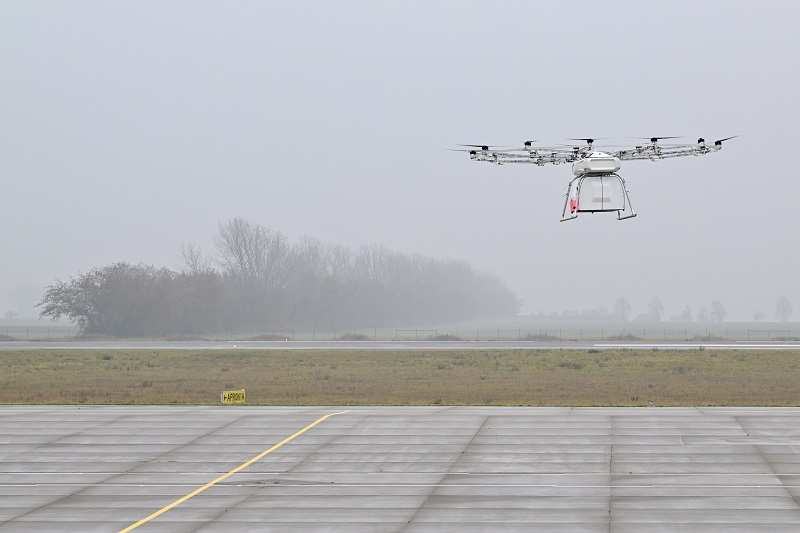Over the past century, the aviation industry has undergone incredible transformations that have revolutionised the way we live, work, and travel. From the introduction of commercial air travel to the rise of drones and Urban Air Mobility (UAM) vehicles, aviation continues to push boundaries and open up new possibilities.
Urban Air Mobility represents the realisation of a long-held dream to enhance transport in and around cities using air travel. With its potential to bypass ground congestion and significantly reduce travel times through point-to-point flights, UAM has the power to reshape the movement of people and goods in urban areas.

Imagine looking up and spotting a flying taxi zipping through the sky and delivering passengers to their destinations. UAM brings together innovative and autonomous airborne technology, using electric and hybrid vertical take-off and landing (eVTOL) aircraft that resemble helicopters. These cutting-edge vehicles are designed to transport cargo or accommodate 1-4 passengers on short trips (less than 100 km), making them perfect for urban areas.
UAM aims to bridge the gap in aviation services by serving urban, suburban, and rural regions that currently lack sufficient transport options. This comprehensive approach encompasses various technologies, aircraft designs, airspace management strategies, operational procedures, and shared services. By integrating these elements into a cohesive and innovative transport network, UAM ensures safety and efficiency levels comparable to the existing aviation system.
However, integrating UAM aircraft and operations into existing airspace presents important challenges in terms of capacity limitations and managing the complexity of multiple airspace users. To address these challenges, research and innovation projects are underway worldwide, with some initiatives already testing aerial prototypes or full-scale eVTOL demonstrators. The goal is to launch initial commercial UAM services within the next 3-5 years, making urban air travel a reality.
To pave the way for the successful implementation of UAM, an evolutionary development process is necessary. This involves defining and deploying advanced and interoperable infrastructure, technologies, and services that align with anticipated operations and demand levels.
Recognising the importance of collaboration, a consortium of research organisations from the European Air Traffic Management (ATM), drone, and UAM industries, led by the EUROCONTROL Innovation Hub, based in Brétigny near Paris, initiated the CORUS-XUAM project. Under the framework of the SESAR 2020 programme, CORUS-XUAM aims to extend the current U-space Concept of Operations to ensure the safe and efficient integration of UAM operations.

U-space, an essential component of this integration, comprises a collection of new services that utilise advanced digital technology and automation to facilitate access to airspace for a large number of drones.
In the short-to-medium term, UAM envisions eVTOL aircraft sharing airspace with conventional manned aircraft. As UAM operations become more autonomous, they will rely increasingly on data-link communication rather than voice communication. eVTOLs will operate in airspace near commercial aviation areas, such as airports, where various airspace users including military, police, emergency helicopters, other drones, and general aviation already operate. The integration of current and future operations in densely populated airspace with ground risks is of utmost importance for ensuring safety and fairness.
Looking to the future, the UAM industry envisions an ecosystem of new vehicle designs, technologies, and shared services that enable a fully integrated transport network with the same level of safety as the current system. To achieve this vision, significant investments are being made by aerospace, automotive, and technology companies in UAM solutions and eVTOL technologies. Various studies and operator insights suggest a future with a substantial number of simultaneous UAM operations in metropolitan areas and around airports, reaching altitudes of up to 5,000 feet and speeds of up to 150 knots.
To realise the full potential of UAM, the management of low-altitude operations will be entrusted to Unmanned Traffic Management (UTM) systems, with traditional Air Traffic Management (ATM) used when safety requires it. The development of smart, automated, and interconnected air traffic management services plays a crucial role in achieving seamless integration of airspace. These advancements are essential not only for UAM but also for priority aviation sectors such as manned security and emergency services.

The ultimate success of UAM operations hinges on identifying solutions that enable unmanned aircraft systems (UAS), UAM/eVTOL, and other airspace users (both unmanned and manned) to operate safely, securely, sustainably, and efficiently within a controlled and fully integrated airspace. In this context, U-space has emerged as a top priority for the aviation industry, as it not only addresses safety concerns, but also unlocks new services and business opportunities.
With ongoing projects like CORUS-XUAM and the dedication of stakeholders across the aviation industry, the future of Urban Air Mobility looks promising. As U-space integration continues to evolve, the skies above our cities will become a thriving ecosystem of innovation, transforming the way we move and unlocking countless possibilities for a more connected and efficient world.

